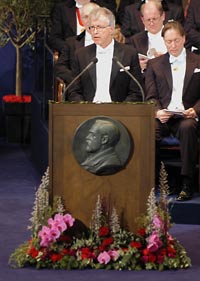Award ceremony speech
Presentation Speech by Professor Lars Thelander of the Royal Swedish Academy of Sciences, December 10, 2004.
 |
| Professor Lars Thelander delivering the Presentation Speech for the 2004 Nobel Prize in Chemistry at the Stockholm Concert Hall. Copyright © Nobel Media AB 2004 Photo: Hans Mehlin |
Your Majesties, Your Royal Highnesses, Ladies and Gentlemen,
This year’s Laureates in Chemistry are being rewarded for their discovery of life’s own death-labeling system and at the same time for having solved a scientific mystery.
The cells in our bodies contain about one hundred thousand different proteins. Proteins do all the work in the cell, and proteins are directly responsible for its shape and function. One of the things proteins do is to build up the molecular machines that form our muscles; another is to form the enzymes that accelerate and control the various chemical reactions that are necessary for life.
Now, how can a cell possibly keep track of all its proteins? Protein molecules are synthesized and broken down all the time at a high rate. As to the synthesis of proteins, we have a good understanding of how this is regulated at molecular level, and the research here has been rewarded with a number of Nobel Prizes. In contrast, the break down of proteins in the cell has been considered less interesting, and it has attracted few researchers.
This year’s Laureates in Chemistry, Aaron Ciechanover, Avram Hershko and Irwin Rose, went against the stream. They studied precisely how the breakdown of proteins is regulated in the cell. What aroused their interest was reports in the literature that the breaking down of proteins inside living cells requires energy. This seemed a paradox since everybody knew that, for example, the degradation of proteins in the intestines – that is, outside the cell – takes place with no requirement for added energy. Why is energy needed for degradation inside cells?
By studying the mechanisms of energy-dependent protein degradation in cell extracts, this year’s three Laureates succeeded at the beginning of the 1980s in identifying a completely new principle for protein degradation. They discovered a system that used a type of “death label” together with three different enzymes to attach it to the proteins to be destroyed. The energy goes to activating the label and enabling the cell to control the process accurately.
The death label itself is a small protein called ubiquitin. The name comes from the Latin ubique, which means ‘everywhere’ and tells us that the protein is found in the cells of almost all organisms. Among all the proteins in the cell, the enzyme system chooses a certain unwanted protein molecule and tags it with the death label. The labeled protein molecule is transported to a type of waste disposer inside the cell called the proteasome, which recognizes the label rather like a key fitting into a lock. Before the labeled protein is sucked into the waste disposer for destruction, the label is removed so that it can be used again to death label more proteins. Inside the waste disposer, the doomed protein is chopped to pieces. These can later be used for synthesizing new proteins. It was first believed that controlled protein degradation is used only to destroy faulty proteins, which may otherwise damage the cell. Prion diseases and Alzheimer’s disease represent similar cases. Yet constantly growing research has shown something more: that it is at least as important for the cell, by destroying a protein with a certain function, to be able to regulate a biochemical reaction, rather like when you turn off a switch. We now know that controlled protein degradation regulates other very important processes in the cell as well. Examples are the cell cycle, repair of DNA damage and immune defense. In plants, the process is also needed to prevent self-pollination. And a failure in our degradation system may lead to disease.
The discovery of controlled protein degradation explains, at molecular level, the function of a regulation system that is very central for the cell. Among other things, the knowledge can be used to produce new medicines against different diseases.
Professor Ciechanover, Professor Hershko, Dr. Rose,
Your discovery of a system for controlled protein degradation in cells has fundamentally changed our way of thinking about protein degradation. We can now understand at molecular level how the cell controls a number of central biochemical processes. More reactions regulated by ubiquitin-mediated protein degradation are being identified every year. On behalf of the Royal Swedish Academy of Sciences, I wish to convey to you our warmest congratulations, and I now ask you to step forward to receive the Nobel Prize in Chemistry from the hands of His Majesty the King.
Nobel Prizes and laureates
Six prizes were awarded for achievements that have conferred the greatest benefit to humankind. The 14 laureates' work and discoveries range from quantum tunnelling to promoting democratic rights.
See them all presented here.
